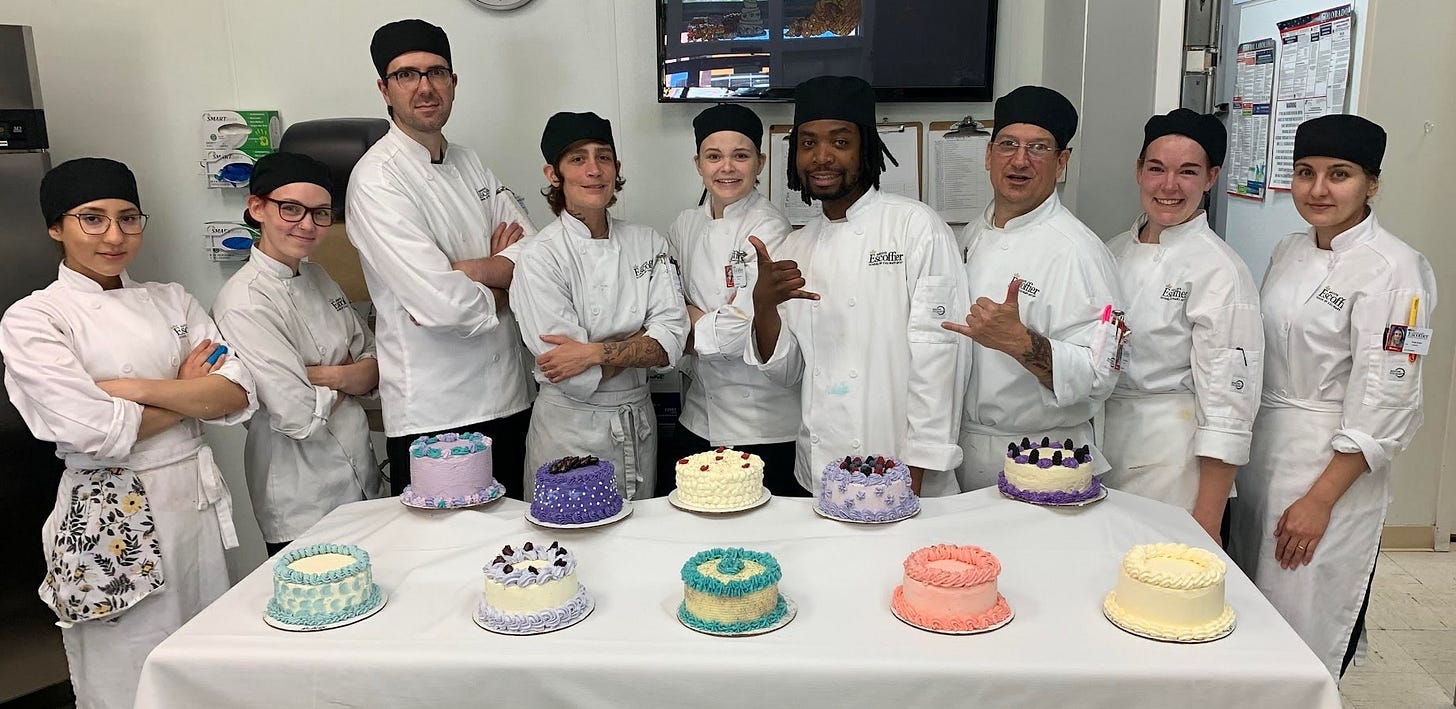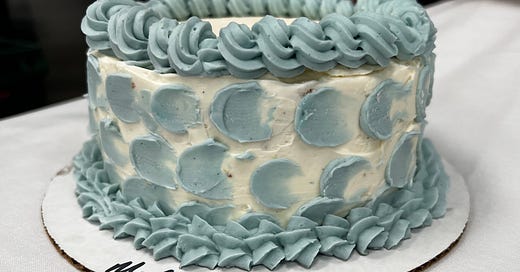Today, our task was deceptively simple: bake and ice an American-style cake. What’s an “American-style cake” you ask? It’s the quintessential cake you might imagine if you were to buy a cake from an American grocery store. Yellow cake, American buttercream – the essence of simplicity. To keep things mildly more interesting (we are supposed to be pastry chefs after all), we would be baking 6” round cakes, making our buttercream from scratch, and adding top and bottom borders to our cake.
“Careful,” warned Chef, “making something simple is not always easy”
After our extravagant swiss rolls, I figured an American cake would be a walk in the park.
The cake
Yellow cake is a classic American recipe that is (surprise, surprise) higher in sugar and fat that other cake sponges more popular on the European continent (Genoise, Lady finger sponge, etc).1 It’s the cake of choice for carved cakes (more on that later) or cakes with many layers, since it is relatively robust and can hold a fair amount of icing weight. It uses a creaming mixing method2 and is relatively simple to prepare. So I was feeling fairly smug as I slid my cakes into the oven and set a timer.
Determining the doneness of a yellow cake (or virtually any cake) is relatively straightforward once you know what you’re looking for: the central dome of the cake should resist a medium-force push from your finger and the side should contract slightly from the sides of the pan. If you’re unsure, you can always stick a toothpick/knife/thermometer3 into the middle and ensure it comes out clean, though doing so has the unfortunately side-effect of turning your cake into a stab victim. After determining my cakes were maybe, probably, almost certainly cooked through, I removed them from the oven and set them on the speed rack to cool.
The icing
If you’ve ever purchased a store-bought cake in the United States, you’ve probably eaten American Icing. It’s that bizarrely artificial, tooth-achingly sweet icing that sets hard when cold and can be dyed any number of unfortunate neon colors. Whereas buttercream icings involve making a meringue, then gradually adding butter (you know, like a civilized icing), American icing is dead-simple to make: take a heaping ton of butter and gradually whip in an unholy amount4 of powdered sugar. Sprinkle in a few drops of vegetable oil and/or water as needed to adjust consistency. The only redeeming quality of this monstrosity is that the icing sets rock-hard when chilled, making it ideal for stacking multiple cake layers together.
I whipped together my batch of icing and sticky hands notwithstanding, was relatively happy with the results.
Assembly
This is where things started to head downhill.
The first part of assembling a cake is to cut off the domed top of the cake to produce a clean, level surface for each cake layer. Chef demonstrated a technique whereby you use your bread knife to carefully slice halfway through the cake, then rotate the cake around the knife to finish the cut. The same technique can then be applied to slicing the cake body into multiple layers. This technique, Chef assured us, would ensure we would produce a clean, level surface.
It did not.
My cake layers looked like a one-handed barber’s first attempt at a flat-top haircut. While blinded-folded. And drunk. Awkward waves of uneven knife cuts criss-crossed my cake with savage imperfection. Even worse, I failed to let my cake cool adequately,5 so the sides crumbled and pulled away when I tried to finish my cut, taking large chunks out of my cake layers.
Oh dear.
I figured I could cover up these sins with some nice icing work. As I started to spread my icing across my cake, three things became instantly clear. First, I had forgotten to brush my cake layers in simple syrup.6 Second, my icing was definitely too stiff and refused to spread in an even layer.7 Third, my cake was still slightly warm, which meant that giant crumbs were instantly lifting up into my icing, marring my sparkling white icing with offensive yellow specks. I quickly decided that I would simple treat this layer of icing as a crumb coat,8 and gritted my teeth through icing the rest of the cake before shoving it into the freezer to set.
Decoration
After about 20 minutes, I pulled my now rock-solid cake from the freezer and started a second coat of icing. I was immensely relieved to see that this layer went on much more easily, since my remaining icing had warmed slightly while resting under my table and the crumbs were mostly locked away in the crumb coat. After covering the full cake, I pulled out my plastic bowl scraper and used the flat edge to smooth the sides and top of the cake.9 This process was more frustrating and less satisfying than hours of scrolling on Youtube had lead me to believe, but I was able to achieve a reasonable result and decided not to mess with it too much.
Finally, it was time to add my decorative borders. I hastily decided to throw in some blue coloring to provide some contrast against the white cake. Then, I loaded my remaining icing into a pastry bag and got to work. It turns out it’s quite difficult to pipe a smooth, perfectly consistent border on a circular object that must be turned at various intervals. Slightly disappointed in my end product, I decided to try smearing some blue frosting onto the side of my cake using my small offset spatula to create a cool fish scale effect I had seen on the internet. Predictably, my results were somewhat less impressive than Instagram would have suggested.
Results
I was feeling pretty good about my finished product until Chef came over to discuss my evaluation with me. He quickly spotted a flurry of flaws in my cake:
Despite my crumb coat, my icing still had visible crumbs in the outer layer
My icing was not perfectly (or really, even remotely) smooth on the sides
The top of my cake was not level
My cake layers were awkward and uneven
My borders were too large for the size of cake
My borders were inconsistent and showed obvious stopping points where I had paused to turn the cake
My “fish scale” effect looked…amateurish at best
Despite the litany of feedback, I left feeling like I had a good understanding of what worked and what didn’t. I felt eager to try again tomorrow and try to improve upon some of my obvious shortcomings.
Finale
Just for fun, we all laid out our cakes on a table and took a picture of the whole class! If you’ve ever wondered who I rub shoulders with on a daily basis, here they are:

Special shout-out to Chef’s “cloud” cake (white with raspberries in the middle) and Asal’s stunning white dream cake (all white in the bottom right). Also, please excuse my expression. I thought we were trying to look “cool.” I was obviously wrong, and I obviously failed at that goal anyway.
Oh well.
Americans seem to be particularly fond of naming cakes after colors and the divine. Yellow cake, white cake, red velvet cake are all American creations as are devil’s food and angel’s food cake. Much to my amusement, Sam had never heard of either angel’s or devil’s food cake and inquired whether this was a delicacy traditionally served at Catholic mass.
To “cream” is to combine butter and sugar into a sand-like paste before alternately mixing in dry and wet ingredients, ensuring full incorporation
Realistically, we always use a thermometer. This is not due to some health obsession with food temperature but rather the fact that our chef whites have a dedicated slot for a food thermometer and we’re required to keep one on our person at all times. It’s usually the fastest thin-and-sharp object available when the panic of trying to assess the doneness of your cake arises as someone starts yelling at you to close the damn oven door already!
A single recipe (enough to ice a single 2-layer cake) calls for A POUND AND A HALF of powdered sugar.
To cut properly, cakes must be absolutely cool. Not mostly cool. Not sort-of a little warmish. Absolutely cool. Seriously – some cake chefs keep their cakes in the freezer to ensure they are cool enough to cut.
It seems bizarre to me that literally all cakes require a simple syrup brush to be merely adequately moist. Surely there must be a way to adjust the recipe itself to produce a good result? Apparently not.
I have since heard that the ideal texture of icing is “like mayo.” While helpful in learning how to ice a cake, I’m afraid my nightmares will never quite be the same after picturing an entire cake slathered in mayonnaise.
The problem of cake crumbs getting into icing is so common that many cake chefs use a first “crumb coat” layer of icing to trap the offending crumbs before covering it with a second layer.




